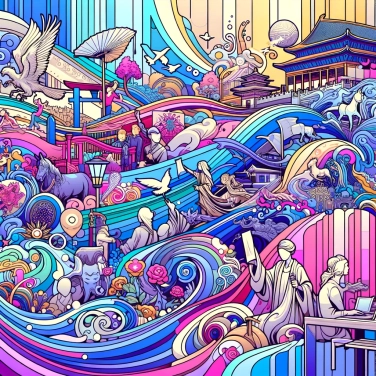Ghost stories are often associated with old houses because of their rich history, unique architectural features, and the presence of unexplained natural phenomena attributed to paranormal activities.

Old houses often have a dark, silent, and dilapidated appearance that stimulates our imagination at the slightest sound. Creaking floorboards, icy drafts, or strange crackling noises can sometimes be enough to create an eerie atmosphere. The lack of lighting, empty rooms with large dusty windows, and the patina of time enhance this feeling of the unknown. Our brains love to imagine the worst when visibility is poor, in those old dark corridors or half-forgotten cellars. This particular atmosphere makes it easy to imagine the presence of ghosts, especially thanks to the moving silhouettes created by the interplay of shadows and light.
Many old houses carry within them the memory of tragic events, such as sudden deaths, serious illnesses, or dramatic accidents. Some places have even witnessed violent crimes or dark stories, leaving behind unsettling tales. These very real historical facts often fuel rumors of ghostly presence. These locations are easily associated with the idea that something gets stuck there, a sort of emotional imprint linked to the troubled past of the inhabitants or the events that occurred there. It is this association that nurtures and strengthens the idea of a direct connection between old houses and ghosts.
Drafts in old homes often create sharp temperature variations and can sometimes give the strange sensation of an invisible presence. Some old houses contain wooden structures that shift: they can produce sudden noises, resembling cracks or footsteps. Similarly, infrasound, very low-frequency sounds that are inaudible to the human ear but perceptible by the body, generate anxiety, discomfort, and sometimes visual hallucinations. Add to this unusual electromagnetic fields, produced by some outdated wiring or old electrical devices, which can induce feelings of presence, fear, or even provoke unsettling sensations. Simple natural light phenomena, such as shadow plays from the passage of an outside light through old shutters, enhance the impression of silhouettes or furtive movements.
Cinema and literature play a significant role in fueling beliefs about haunted houses. Classics like Amityville, Shining, or the films from the Conjuring saga mark our collective imagination. Television shows intended to track ghosts also contribute to reinforcing this supernatural perception: every strange noise ends up being seen as evidence of a spirit's presence. Through repetition and staging, these stories deeply permeate popular culture, making old houses even more creepy and mysterious in the eyes of the public.
The term "poltergeist" originates from German, composed of "poltern," meaning to make noise, and "geist," meaning ghost, highlighting the imagined presence attributed to unexplained sound manifestations.
A survey conducted in the United Kingdom reveals that up to 40% of the population admits to having felt or perceived a strange "presence" in their home, particularly in old or isolated houses.
According to a study conducted by the University of Westminster, the beginnings or ends of the day, times when our brain is more fatigued, are particularly conducive to illusions that lead us to think about supernatural phenomena.
In ancient architecture, the wood and natural materials used can produce unusual sounds such as creaks or cracks when temperature and humidity change, thus explaining certain phenomena referred to as paranormal.
Yes, many natural phenomena, such as the pareidolia effect (identifying familiar images in vague shapes), infrasound that is imperceptible to the human ear, or even electromagnetic fields, can cause inexplicable sensations often attributed to ghosts.
These stories often reflect common anxieties about death, the unknown, and the past. Cultural sharing facilitates the international transmission of these legends, enhancing their popularity and similarity across cultures.
Films, series, and television documentaries shape and amplify our vision of ghosts and old houses. These media representations create powerful stereotypes and reinforce our tendency to perceive simple anomalies as paranormal phenomena.
Old houses accumulate structural creaks, drafts, and poorly lit areas that become particularly noticeable and unsettling at night, thus activating our imagination and reinforcing our instinctive fears.
Always be cautious: respect private property, never visit abandoned or dangerous places alone, and make sure to carry a flashlight and a fully charged mobile phone. Maintain a critical mindset to avoid confusing imagination with reality.

No one has answered this quiz yet, be the first!' :-)
Question 1/5